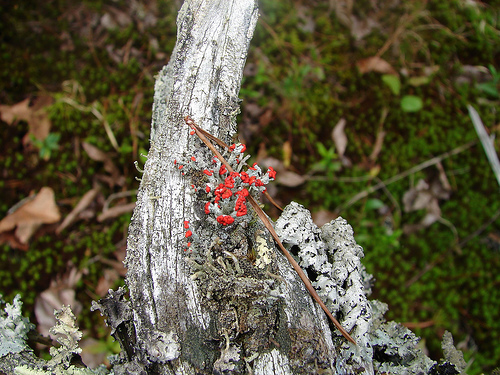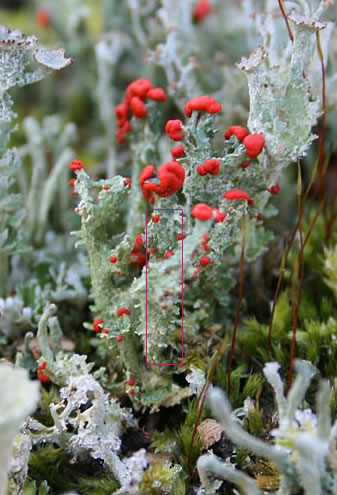Nutrient Acquisition
As you may know, lichens are organisms that exhibit symbiotic relationships with either a photosynthetic cyanobacteria or algae. Cladonia cristatella demonstrates symbiosis with Trebouxia erici, a type of algae. The photosynthesis of this organism provides many of the required nutirents for C. cristatella to survive. In addition to obtaining sustenance from its photobiont (that's a fancy word for T. erici in this relationship), C. cristatella also gains nutrients from the surrounding environment. When it breaks down dead organic matter such as fallen trees and stumps, minerals and vitamins are taken up. The algal symbiote can provide glucose as a source of energy but not much else. In order for the fungi to obtain other building blocks for life, it's necessary for the fungus to do some of the work.
Many lichens also can absorb micronutrients such as copper and iron through water runoff and even the air if not growing near a source of organic material. This would be useful for lichens growing on rocky environments without soil available.
Optimal growth conditions for many lichens occurs in moist environments. According to research, 50-80% saturation of the thallus is needed for a maximum photosynthetic rate to be achieved. If the water content gets too low, the organism will start to lose photosynthetic activity.
Reproduction
As with many fungi, Cladonia cristatella exhibits an alternation of generations. Since this fungus falls under the ascomycota phylum, it follows the same general progression when undergoing reproduction. Due to the fact that Trebouxia erici resides within the C. cristatella, its mechanism of reproduction is somewhat limited. If this organism existed freely, it would have the ability to sexually reproduce, but since it permanently resides in the fungus, the only way these organisms reproduce is asexually.
As can be seen, the largest part of the lichen is the thallus, which is marked in magenta. This part is responsible for about 90% of the organism's height. The top, which is red, is called the apothecia. These structures release spores into the environment. Due to the slow rate of growth in these organisms, it can take years before they reach sexual maturity. The true means of sexual reproduction in these species is not known since it has been very difficult to observe this; however, it's hypothesized that the mechanism is similar to that of fungi.
Hypothesized steps in Cladonia cristatella sexual reproduction:
- Female filaments produced are called trichogynes.
- These cells are fertilized by conidia, or the male cells. These are thought to occur elsewhere on the organism or from other nearby organisms.
- This exchange of genetic material produces ascospores.
- Lastly, they are released from the many apothecia on the top of the lichen.
In addition to reproduction sexually, Cladonia cristatella is capable of asexual reproduction. The most common way this happens is by a chunk of the organism breaking off and growing elsewhere in a suitable habitat.
Fragmentation is the most common form of reproduction in this species, and as a result, sexual reproduction often lacks success. This is because sexual reproduction does not transmit the genetic material for the photobiont. Since Trebouxia erici does not occur naturally outside of the lichen thallus, this can be rather difficult to accomplish.
Division of Cells
This is an important topic when talking about a photobiont and a mycobiont. It's important to know that all photobiont cells are extracelluar. Also, one fungal hyphal projection contacts each algal cell, and when the Trebouxia photobiont divides, the fungal projections branch, make contact with daughter cells, and in doing so separate out the algal cells.
A true understanding of the mechanism behind lichen growth, including Cladonia cristatella, is difficult to observe due to the fastidious nature of these organisms. Attempts at growing lichens in a laboratory setting have proven to be extremely difficult to nearly impossible, depending on the species. Cladonia cristatella is one of the few species that has been cultivated in a laboratory setting, and as a result, a better understanding of this organism exists compared to some of the other lichens.
Cladonia cristatella has been used in experiments to try and reconstruct the lichen thallus from separate partners. This involves keeping the photobionts mycobionts in close proximity, with the photobionts being kept in low nutrient conditions for many months. Cladonia cristatella and Xanthoria parientina are the only lichens that we've been able to synthesize successfully from the separate photobiont and mycobiont. Note however that this does not normally happen in nature, as Trebouxia erici does not exist by itself in nature, only as a photobiont.


